Quasicrystal structure based on the golden mean won Daniel Shechtman the 2011 Nobel Prize in Chemistry; Dr. Mae-Wan Ho finds out why it is a thing of beauty
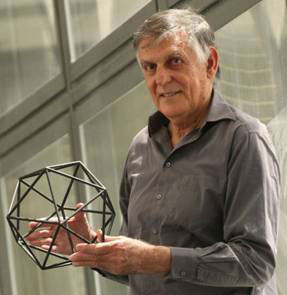
Daniel Shectman with quasicrystal icosahedron
Dan Shechtman looked down the electron microscope on the morning of 8 April 1982 and saw the crystal structure of an aluminium and manganese alloy (Al6Mn) that he had created. It was impossible! He could not believe the structure could exist. A later diffraction pattern obtained with a larger crystal under X-ray showed concentric circles, each with ten bright dots that were equidistant from its neighbours (Figure 1) [1, 2]. He had rapidly chilled the molten metal, and expected the sudden change in temperature to have created complete disorder. Instead, there was order of a different kind from any crystal previously known to exist. He had created a new kind of ordered structure called a quasicrystal. But it took quite a while for the scientific community to accept his finding.
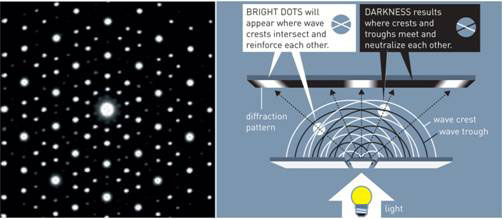
Figure 1 Diffraction pattern of Dan Shechtman’s crystal (left) and how it was obtained
“I told everyone who was ready to listen that I had material with pentagonal symmetry. People just laughed at me,” Shechtman recalls when interviewed in his office at the Israel Institute of Technology, Haifa, Israel, surrounded by numerous prizes he has won before the crowning glory of the Nobel award [3].
In fact, Shectman lost his job soon after his discovery. Linus Pauling accused him of “talking nonsense”, and delivered the ultimate insult [4]: “There is no such thing as quasicrystals, only quasiscientists.”
A quasicrystal is an ordered structure that is not periodic. It can continuously fill all available space, but it lacks translational symmetry, which means that an arbitrary part of it cannot be shifted from its original position to another place without destroying the symmetry. While crystals, according to the classical ‘crystallographic restriction theorem’, can possess only two, three, four, and six-fold symmetries, quasicrystals show other symmetry orders, for instance five-fold.
Paul J. Steinhardt, professor of physics at Princeton University, New Jersey, in the United States defines quasicrytals more precisely as quasiperiodic structures with forbidden symmetry that can be reduced to a finite number of repeating units [2]. These structures were inspired by Penrose tilings in two dimensions.
Aperiodic tilings were discovered by mathematicians in the early 1960s. In 1972, Roger Penrose created a two-dimensional tiling pattern with only two different pieces that was not periodic and had a five-fold symmetry (see Figure 2).
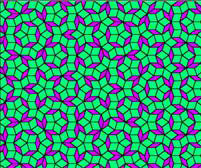
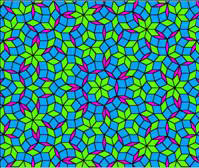
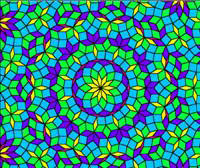
Figure 2 Penrose tilings from John Steinhardt with 5, 7 and 11-fold symmetries (left to right) [2]
Quasicrystals are higher dimensions Penrose tiling (and obey rules other than what Penrose had discovered). They are a new class of solids not just with 5-fold symmetry, but any symmetry in any number of dimensions [2]. This includes a dynamic icosahedron quasicrystal structure of 280 molecules of water discovered by Martin Chaplin at South Bank University, London, in the UK [5, 6] (see Two-States Water Explains All? SiS 32).
An intriguing feature of quasicrystals is that the mathematical ‘irrational’ constant (irrational because it cannot be expressed as a fraction) known as the Greek letter j, or the “golden ratio” is embedded in the structure [5, 7], which in turn underlies a number sequence worked out by Fibonacci in the 13th century, where each number is the sum of the preceding two.
Two quantities are in the golden ratio if the ratio of the sum of the quantities to the larger quantity is equal to the ratio of the larger quantity to the smaller one. The golden ratio is approximately 1.61803398874989. Other names frequently used for the golden ratio are the golden proportion, the golden section, or golden mean.
The Fibonacci sequence is a sequence of numbers, 1, 1, 2, 3, 5, 8, 13, 21, 34, 55, 89, 144, ….., where the ratio of a number in the sequence to the previous approaches j asymptotically, i.e., more and more exactly as the numbers get larger and larger.
The golden mean was the Greek ideal of beauty and harmony, and had a tremendous influence on architecture, art and design.
It is significant that quasicrystals do represent minimum energy structures [2, 5], and hence a kind of frozen equilibrium between harmony and tension in just the right degree, which may be where beauty lies.
Article first published 07/11/11
Comments are now closed for this article
There are 5 comments on this article.
Sibylle Gabriel Comment left 8th November 2011 08:08:36
It is where beauty lies and I am very happy that we are slowly coming to the truth.
Todd Millions Comment left 20th November 2011 19:07:05
Synergetics II by Buckminister Fuller-the illistration for 'strut bonded tensigrity Icosa's,'with the -'bow tie voids' between them.
Thus were quasi crystals predicted,and one could predict certian features not yet noticed in the original pictures.
So far as I've ever known,I was the only one too notice this.
yezude Comment left 15th June 2013 23:11:38
golden section is the organisation of this universe
MSalahE Comment left 27th October 2014 16:04:14
Scholarly articles for el naschie and thooft Elementary ...
https://plus.google.com/.../posts/g96Nx7uTonW
Mohamed El Naschie
5 days ago - Scholarly articles for el naschie and thooft. Elementary prerequisites for< i> E-infinity:( … - El Naschie - Cited by 155 … Kähler manifolds, Klein modular space ...
Scholarly articles for el naschie and thooft Elementary ...
https://plus.google.com/.../posts/hjwW46mLFLR
Mohamed El Naschie
5 days ago - Scholarly articles for el naschie and thooft. Elementary prerequisites for< i> E-infinity:( … - El Naschie - Cited by 155 … Kähler manifolds, Klein modular space ...
assem deif Comment left 13th October 2016 21:09:37
3 comments:
1. The golden section is not the Greek ideal of beauty. It was mentioned in Euclid book "the elements". Euclid origin is unknown. Smith called him Euclid of Alexandria. Many Egyptians were given Greek names. Ptolemy the astronomer is from upper Egypt, so is Eratostenes from Salloom. I have a Muslim friend who is an Egyptian peasant who called his daughter Nancy. I am sure she is not American
2. Much earlier than Euclid many Egyptian monuments carry these proportions as was documented by the Egyptologist Shwaller de Lubic
3. Fibonacci sequence not necessarily 1,1,2,3,5,... you can start with any 2 numbers 5,2,7,9,16,... the ratio of 2 consecutive no's tend to phi